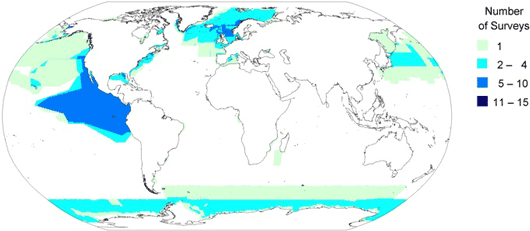What lies beneath?

Marine mammals are at risk because so little of the world’s oceans have been adequately surveyed, new research has revealed.
The research into populations of cetaceans, by scientists in Scotland and Germany, points to dangerous gaps in the knowledge of species at risk from human activity including military sonar, and bycatch in fisheries.
Academics at the University of St Andrews and the University of Freiburg studied more than 1100 estimates of the abundance of whales, dolphins and porpoises reported in more than 400 surveys conducted worldwide between 1975 and 2005. The painstaking research found that a mere 6 per cent of ocean surfaces have been surveyed adequately.
Human ability to protect cetaceans from threats such as seismic surveys (for offshore oil exploration) and oil spills, hinges on good information, and this latest research indicates a lack of baseline information to evaluate threats across the vast majority of the world’s oceans.
Dr Nicola Quick, co-author and honorary research fellow from the University of St Andrews, said: “One of the primary motivations for our research was to know where whales might be most vulnerable to the use of military sonar or seismic surveys to find oil under the seabed.
“The enormous data gaps we found in our study remind us that we still have a lot of work to do to predict whether vulnerable species might be using the waters that have never been surveyed. We recommend international coordination of surveys to share resources to fill in these gaps.”
During the research, the team digitised thousands of maps and their analysis generated some surprising results about the global patchiness of whale and dolphin research. The study found that overall only 25 per cent of the world’s ocean surface has been surveyed at all, while only 6 per cent has been covered well enough to offer any hope of detecting trends in population size.
Key findings included:
- The vast majority of surveying effort has taken place in waters under the jurisdiction of wealthy, northern hemisphere countries like the US, Canada and Europe.
- Southern hemisphere regions are underrepresented, except the Antarctic, where the International Whaling Commission leads surveys to estimate abundance of the Antarctic minke whale, which is subject to scientific whaling by Japan.
- Few surveys have taken place in high-seas waters beyond national jurisdiction. This hinders global initiatives to implement high-seas marine protected areas that reflect the habitat needs of whales and dolphins.
- The level of survey effort conducted in the eastern tropical Pacific may look excessive but is actually at the low end of what is needed to detect population trends.
- The main focus for surveying populations was in tuna fishing regions due to the market for “dolphin-friendly” tuna, with more surveys in the eastern tropic Pacific Ocean than in the rest of world combined.
As international efforts are underway to protect global biodiversity, the researchers conclude there is an urgent need to develop new field and statistical/ analytical methods to fill in data gaps which can in turn improve marine conservation efforts.
Lead author, Dr Kristin Kaschner of the University of Freiburg, said: “The rest of the world has a lot of catching up to do if we want to know if whale populations are recovering from historic whaling or bycatch in fisheries.
“The issue of data gaps pervades every issue in marine planning, from fisheries management to marine protected areas. Because of the strict science needs of whaling, the information available on whales and dolphins may paint an optimistic picture of marine science. Knowledge gaps are almost certainly worse for deep-sea invertebrates, sharks or marine viruses.”
Dr Rob Williams, co-author and Researcher in the Sea Mammal Research Unit at the University of St Andrews, added: “One of the most important management and conservation decisions we make is how to allocate scarce funding for research.
“As we aim to protect marine biodiversity on a global scale, we need to ensure that our scientific advice reflects the fact that the vast majority of the world ocean has never been surveyed in a comprehensive way. If we ignore that, our advice is biased toward coastal waters of wealthy countries, and that is unjust.”
The study is published in the open access journal PLOS ONE.
As part of its 600th anniversary campaign, the University is currently fundraising for a new £12m Centre for Earth, Life and the Oceans, which will allow vital fieldwork and help to progress understanding of life underwater. The new centre will incorporate the existing world-class Scottish Oceans Institute, established by the University in 2009.
Note to Editors
For wildlife images and a colour map, contact the press office.
Dr Rob Williams is available on 01334 46 3617 or on email at [email protected]
Dr Kristin Kaschner is available by email at: [email protected]
Dr Nicola Quick is available on 07825 634945 or at: [email protected]
The journal article is available at http://dx.plos.org/10.1371/journal.pone.0044075
Issued by the Press Office, University of St Andrews
Contact Gayle Cook on 01334 467227 or Fiona MacLeod on 01334 462108 / 0771 414 0559.
Ref: (cetaceanmap 13/09/12)
View the University’s latest news at www.st-andrews.ac.uk/news
Category Research